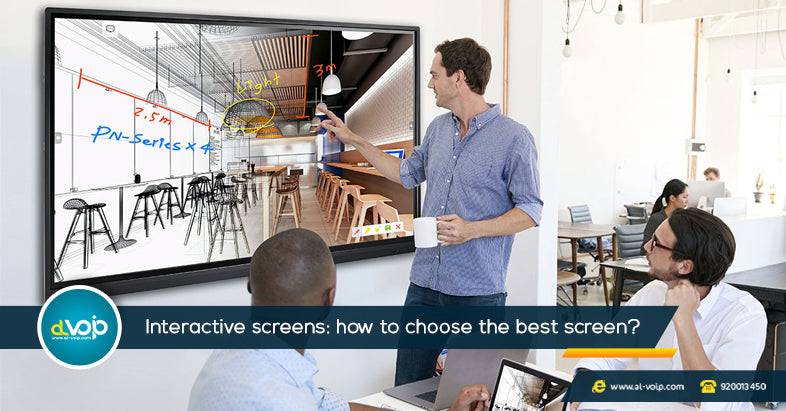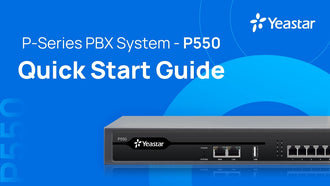

Interactive screens: how to choose the best screen and use it to increase your business productivity? Complete guide
- 22 Feb, 2021
In the world of digital technologies and its rapidly growing generations, the way we work, learn and collaborate has been transformed excitingly. This massive transformation depends on having the right technology. And this technological breakthrough is where the interactive flat panel displays come in or what we call now IFPD.
Successful and leading companies are kitting out their meeting rooms and huddle spaces with the latest interactive touch screens panels and content sharing applications to encourage and facilitate cooperation working, ideas visual sharing, and endless possibilities for interactive collaboration. And you should do the same too.
Whether it is in a classroom or working space, no doubt that collaboration is essential to an effective environment. And interactive technology has become the key to achieving this.
According to the latest statistics, the global interactive flat panel display market was only worth 1.37USD billion in 2015 but the new generation displays are making their way into modern classrooms, meetings, and conference rooms. That's why the interactive flat panel displays market size has the potential to grow by 40.61USD billion during 2020 – 2024, and the market growth momentum will accelerate during the forecast period.
If you have ever wondered:
- What is an interactive screen?
- How can it benefit business and educational institutes alike?
- how to choose the interactive screen that fits your business or your home?
Then you came to the right place. We create this ultimate guide to interactive touch screens to answer and explain all of your questions in more detail.
Make sure to read on to know more exciting information about interactive touch screens and their application in business, schools, and more.
What is an interactive flat panel display “IFPD”?

IFPD is a short of interactive flat panel display and it is "a large-format touchscreen display available in a variety of sizes, ideally used for collaborative spaces and meeting rooms. It is usually powered by Android but users have the option to add-in windows OS so they can use all their familiar software.
Considering its multiple size availability, interactive flat panel displays have replaced the outdated projector technology because of its higher quality, lower price, enhanced connectivity, and built-in software solutions.
Users interact with these displays by using their fingertips and some interactive screens include an enhanced electromagnetic pen with user buttons to facilitate multitasking during the meeting or presentation.
What makes the interactive screens special and productive solutions is that they are perfect for all collaborative spaces ranging from small classrooms to expensive corporate boardrooms and even at home leisure.
What are interactive flat panel displays “IFPD” also known for?

Because interactive screens are a new technology and have been used in many areas, they got plenty of names. And you may read or hear one of these names.
Interactive flat panel displays are also known as:
- Interactive touchscreens
- Large-format interactive displays “LFID”
- Interactive LCD touchscreens
- Interactive display boards
- Interactive whiteboard with PC
- Smart screen
- Smartboard
Whatever the names that describe this modern technology, they are all used for the same main purpose which is to allow users to interact with different types of content, productive collaboration and learn better.
What are the types of flat interactive screens?

Here we are trying to clarify some of the interactive screens types. All interactive screens have almost the same purpose and the following classification is just to give you more knowledge.
- Interactive whiteboards
Whiteboards allow for varying degrees of collaboration. Basic models are an excellent solution for meetings and presentations. The next-generation models added more essential features such as cloud portability and enterprise-level security.
Today the new models have become more essential to meeting rooms as it enables better collaboration. It enables users to use their own devices during presentations through wireless connections.
- Interactive flat panels
Interactive flat panels are office display solutions it's mainly used for collaboration (including remote working) . Its security features are enhanced and you can extend accessories for higher performance during large meetings and video conference experiences. This slim touchscreen can be mounted on the wall or mobile stand
- Interactive multi-touch display
It is a display monitor that allows for more than one-touch control of the screen which allows for enhancing interactivity, creative brainstorming, and total group collaboration.
- Interactive panel displays
Flat-panel monitors are used to display information in public or closed places.
- Interactive projectors
It allows for collaboration with a projector in a meeting room.
- Interactive retail display
A monitor setup for public use to interact with product information.
- Interactive store displays
Provide interactive experience to the customers by allowing them to try the products virtually.
Note there are many types of flat screens such as "plasma, LCD, OLED, LED, ELD, SED, FED, and NED" the first four types are already in markets and making waves worldwide. But the last three are relatively new technology and aren't yet commercially available.
What is the interactive screen size?

As I told you earlier, interactive screens come in multiple sizes and that means there are options available to suit any type of business from the smallest meeting room to the biggest boardroom.
Most screen sizes vary between 55 to 96 inches in size.
Pro tip: it is always advisable to choose a screen that is as big as possible, most businesses choose 75 and 86 inches size to get inclusive experience as well as helping to future proof any growth in room size.
When did the interactive screens come in?
Interactive screens are considered newly emerging. However, technology has been making its way into business facilities and classrooms since the early 1990s.
The first application of this technology was the interactive projector which enables the presenters to share their computer screen or conferencing feed with the entire board room. It was considered a great advancement at this time. But they were ultimately limited by input restrictions and environmental factors.
Now, interactive displays have been improved and allow users not only to share content more clearly but also use touchscreen capabilities to facilitate a more engaging experience for the entire audience.
How to use interactive screens in different sectors?
The main benefit of interactive screens is increasing collaboration and productivity in the workplace. It makes group work easier than ever, as each student, staff member, or even the public can use it seamlessly with countless tasks.
Here we will try to spot the light to the benefit of interactive screens in different sectors:
Interactive screens in working space and meeting rooms

Interactive screens can be used effectively in a business setting. It makes the perfect addition to any meeting or conference room. Teams need resources to collaborate, be productive, and become more efficient.
Here where interactive screens' role comes through the following features:
Collaborative interactive touchscreens: interactive screens utilise touch technology in the office environment. Everyone can simultaneously write, annotate and edit files fairly.
More effective presentations: interactive screens allow the presentations to become more dynamic, engaging, and inclusive. Colleagues can add writing drawings to the screen which makes the session more interactive and memorable.
Interactive screens make business meetings better: they encourage every member of the staff to collectively add their ideas and suggestions to documents. And everyone will play a role rather than just sitting.
Seamless content sharing: interactive screens allow you to share the content on the screen with the meeting members in real-time.
No waste time in meetings: interactive screens take no time to start so, you won't waste any time setting up and preparing any projectors or massy wired devices.
It goes wherever you want: most interactive screens can be carried by a mobile stand. So, interactive screens can go anywhere as your space evolves, scales or shrinks.
Interactive screens help everyone in the room to focus on the content: its optimised viewing angles, pixels, and brightness. Most of it comes with 4k resolution.
Interactive screens in classrooms

“If we teach today’s students as we taught yesterday, we rob them of tomorrow”
This quote describes exactly why we should use interactive touch screens in classrooms. It became indispensable in the modern learning system.
As we become aware of the inadequacy of traditional teaching methods, we should focus on making lessons more diverse to cater to different children’s learning requirements and preferences.
Interactive screens could be the perfect addition to any classroom in several ways:
Two-way screen sharing: allow the teachers to share any file or document from his device to the interactive screen, as well as sharing the content that is created on the screen to students' laptops or tablets.
Apps for the classroom: many interactive screens come with preinstalled apps including Microsoft office suite which allows users to open and edit documents.
Free to download content: on the interactive screens provides teachers with access to a vast library of multiple contents to enhance their lessons illustration.
Help teachers to focus: interactive screens help teachers to focus on the lesson’s content they have prepared and less focus on their teaching materials.
4k resolution interactive screens: means that students can have a clear vision of the content where they are sat in the class.
Get the whole class involved: especially for students who may not like speaking up in class, interactive screens allow them to actively engage in a way they feel comfortable.
Interactive screens in retail

Interactive screens have been used for several years in retail and proved of great value to enhance the buying experience.
Interactive screens are used in retail:
- To show the newest in-store arrival products
- To instruct people how to use the products.
- To grab the attention of people passing by.
- To improve the customer service experience as following:
- Interactive screens are used in self-service kiosks to help users complete a check out on the spot without requiring any staff.
- Allow customers to try on products and explore different possibilities before making purchasing decisions through interactive mirror touch screens which give them an impressive experience.
Why do you need an interactive screen – IFPD?

- Cost savings: interactive screens encourage cost savings in several ways such as:
-
Interactive screens are less invasive on the infrastructure
-
It is an all-in-one design so there is no need to worry about rewiring the ceiling or breaking into wales.
-
IFPD is an office display solution that works with a wide range of software with fewer licences to purchase.
-
IFPD simply plugs an outlet just like a TV monitor.
- Great security & privacy features: IFPDs today have great concerns about security, so they come with security features to protect business assets as well as attendees' privacy like:
-
Biometric authentication
-
Multi Factor authentication
-
Lens camera that only opened in video conference meetings.
-
Single sign-on
- Innovation: IFPDs enable your business to benefit from using and implanting the latest innovative and collaborative practices and technology and be a leading user.
- ROI: IFPDs allow for an easily scaled solution, which can lower costs over time for a growing enterprise. Add to this, many unified communication restrictions that were present in older technology have been removed in the next IFPDs solutions.
What are the top 11 interactive screen brands?
There are several brands within the interactive screen marketplace. Here is a list of the top brands to interactive screens sorted by the features offered by each brand:
-
Maxhub Global
-
Ben Q
-
LG
-
Promethean world
-
Samsung
-
Hitachi
-
Globus Infocom
-
Box light
-
Egan team board
-
Vestel
-
Julong Edu
If you need a comparison and a review for each brand let us know in the comments or simply give us a call.
7 essential features to look for in every interactive screen?
-
Large Screen size: your interactive screen usage is going to dictate the size you purchase. However, we always recommend the bigger size for offices to fit all spaces.
2. Connectivity: it's extremely important as you want a member to log on and participate whether on PC, tablet, or mobile. Always make sure that your interactive screen has multiple connection ports wired and wireless.
3. Compatibility: you need full compatibility so you can easily share the content on your screen and use native casting to stream any media you have. Make sure your interactive screen is compatible with windows, Android, or IOS.
4. User interface: make sure the interactive screen interface is easy and like what you are familiar with.
5. Camera and accessories: interactive screen camera is considered an essential part of your screen. And make sure you buy all the additions you may use such as the PC model and make sure it has enough ports to connect all accessories.
6. Write into files: writing is one of the key factors to interactive screens. Choose an interactive screen with enhanced writing capabilities and an electromagnetic pen.
7. Multi User collaboration: this means staff members can write, erase and edit images on screen simultaneously.
How to choose the best interactive screen for your business?

There are fundamental considerations that you should compare and review besides the price if you want to choose the ideal interactive screen for your business. And these considerations are:
-
Hardware specifications: it's very essential to consider the hardware in your interactive screen and it includes:
- Screen Resolution: it plays a vital role in your meeting experience. Small scale rooms can use 1080p FHD displays. Larger rooms can benefit from 4k UHD resolution.
- Size: it also has a relation with your meeting room. Typically, a 65 inches screen is fine for a small space –less than 5 persons- while a 75 inches screen is suitable for a medium–sized meeting room -5-10 persons- and 86 inches is perfect for a board room area –more than 10 persons.
- High Connectivity: your screen must allow the users to wirelessly connect their devices. And take into account important ports (HDMI, VGA, displayport signal inputs. USB, pc slot, and LAN & WIFI)
- Touch and stylus: pick an interactive screen with enhanced touch and 20 touchpoints. -
User experience:
- Home screen: make sure to choose an interactive screen with a friendly interface to avoid confusion among users.
- Annotation tools: picking interactive screens that utilise an intuitive annotation toolbar capable of offering useful functions with less learning curve.
3. Business meeting collaboration: if you a high level of efficiency and engagement in your meeting room, your interactive screen must include:
- Supporting multiple files formats
- Mirroring from mobile devices
- Cloud drives
- QR code scan and save – you will no longer need to take a picture to save meeting files and spend time using a document application. QR code scan and save can download exact files on your interactive screen.
Conclusion
We have clarified in this article how interactive screens could be a giant evolutionary leap for all business collaboration practices. Interactive technology can improve your life in several ways from business meetings and seminars, educational purposes, and even advertisements in malls, shops and retails.
Making sure you have the technology you are going to need is the key to seeing the difference in results.








